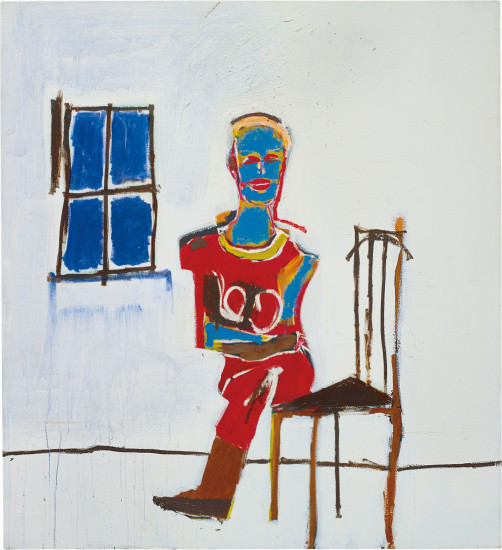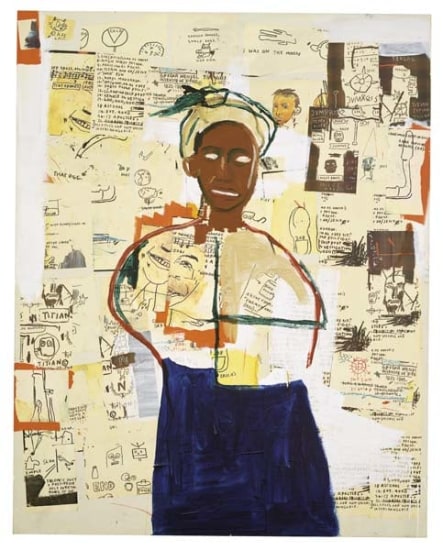PROPERTY FROM A PRIVATE EUROPEAN COLLECTION Jean-Michel-Basquiat Back of the Neck 1983 Screenprint in colours with hand-colouring, on Stonehenge heavyweight paper, the full sheet, S. 127.8 x 258.3 cm (50 3/8 x 101 3/4 in.) signed, dated '83' and annotated 'A.P.1' in pencil (one of 3 artist's proofs, the total edition was 24 including a bon à tirer), published by New City Editions, Los Angeles, framed.
Provenance Ikon Ltd Gallery, Los Angeles Acquired directly from the above by the present owner Exhibited New Orleans, Ogden Museum of Southern Art, Prospect.3, Basquiat and the Bayou, 25 October 2014 - 25 January 2015 (another example exhibited) Los Angeles, Gagosian Gallery, Jean-Michel-Basquiat: Paintings and Drawings, 1980-1988, Feb - Mar 1988 (another example exhibited and illustrated in colour, no. 17) Paris, Galerie Enrico Navarra, Jean-Michel-Basquiat: Paintings, Sculptures, Works on Paper and Drawings, 1989 (another example exhibited and illustrated on pp.36-37) New York, Vrej Baghoomian, Inc., Jean-Michel-Basquiat, Oct - Nov 1989 (another example exhibition and illustrated in colour on p.69) Literature Richard Marshall, Jean-Michel-Basquiat, New York, 1992 (another example illustrated in colour, p.243) Jean-Michel-Basquiat, Jean-Michel-Basquiat: King for a Decade, Japan, 1997 (another example illustrated in colour, p.80) Tony Shafrazi, Jean-Michel-Basquiat, New York, 1999 (another example illustrated in colour, p.175) Enrico Navarra and Richard Marshall, Jean-Michel-Basquiat: Works on Paper, Paris, 1999 (another example illustrated in colour, pp. 342-343) Catalogue Essay “ I don’t think about art when I’m working. I try to think about life.” -- Jean-Michel-Basquiat At the age of seven, Jean-Michel-Basquiat was playing ball on his street in Brooklyn when he was hit by a car, resulting in a broken arm and various internal injuries that led to a month’s recuperation in hospital. During his incarceration, his mother gave him a copy of the medical text, Gray’s Anatomy. Filled with detailed anatomical drawings and diagrams, this book had a profound influence on the young artist who, throughout his oeuvre and particularly in his drawings and prints, has compulsively detailed fragments of the human body. The artist’s obsession with anatomical imagery is evident in his first experimentation with printmaking: the two series Anatomy, 1982 and Untitled (from Leonardo), 1983. These stark monochromatic prints diagrammatically catalogue a variety of individual body parts, almost as a child’s homework would name the various joints and ligaments. However, it is only in the present lot, Back of the Neck that these disparate limbs are combined to create an image that transcends the sterile illustrations of medical textbooks. In the present lot, Basquiat penetrates the human figure with a unique x-ray vision, presenting the viewer with a skeletal spine flanked by two dismembered arms: one almost entirely clad in flesh, the other flayed to muscle and sinew. The artist’s disquieting cross-section of a human figure calls to mind Gerard David’s The Flaying of Sisamnes, 1498, wherein the peeling of the corrupt judge’s skin away from his lower leg is carefully rendered in grotesque detail. Basquait explained that he was, “…interested in painting the black person, he’s the protagonist in most of my paintings.” Yet if that is the case in Back of the Neck then the black person he is depicting appears hardly as a protagonist, remaining both faceless and nameless. The artist chose instead to spell out (in aggressive white lettering) the compartmentalised sections of the body he is displaying, including his trademark copyright sign to individually brand the isolated limbs. The subject of this work has been torn asunder, his body parts scattered across the paper, exuding perhaps the intensely felt, but fragmented experience of the artist’s astronomic acceleration to fame, and the scrutiny he faced in a culture that both rejected and exoticised Basquiat as a black artist. As Dick Hebdige has stated, Basquiat was obsessed “with the black male body’s history as property, pulverized meat and popular entertainment…” and as a black artist, was acutely aware of “performing the splitting, doubling, and stitching-up procedures which lie behind a production of identity.” Back of the Neck, redolent with taut energy in its expressive lines and rich, violent colo
PROPERTY FROM A PRIVATE EUROPEAN COLLECTION Jean-Michel-Basquiat Back of the Neck 1983 Screenprint in colours with hand-colouring, on Stonehenge heavyweight paper, the full sheet, S. 127.8 x 258.3 cm (50 3/8 x 101 3/4 in.) signed, dated '83' and annotated 'A.P.1' in pencil (one of 3 artist's proofs, the total edition was 24 including a bon à tirer), published by New City Editions, Los Angeles, framed.
Provenance Ikon Ltd Gallery, Los Angeles Acquired directly from the above by the present owner Exhibited New Orleans, Ogden Museum of Southern Art, Prospect.3, Basquiat and the Bayou, 25 October 2014 - 25 January 2015 (another example exhibited) Los Angeles, Gagosian Gallery, Jean-Michel-Basquiat: Paintings and Drawings, 1980-1988, Feb - Mar 1988 (another example exhibited and illustrated in colour, no. 17) Paris, Galerie Enrico Navarra, Jean-Michel-Basquiat: Paintings, Sculptures, Works on Paper and Drawings, 1989 (another example exhibited and illustrated on pp.36-37) New York, Vrej Baghoomian, Inc., Jean-Michel-Basquiat, Oct - Nov 1989 (another example exhibition and illustrated in colour on p.69) Literature Richard Marshall, Jean-Michel-Basquiat, New York, 1992 (another example illustrated in colour, p.243) Jean-Michel-Basquiat, Jean-Michel-Basquiat: King for a Decade, Japan, 1997 (another example illustrated in colour, p.80) Tony Shafrazi, Jean-Michel-Basquiat, New York, 1999 (another example illustrated in colour, p.175) Enrico Navarra and Richard Marshall, Jean-Michel-Basquiat: Works on Paper, Paris, 1999 (another example illustrated in colour, pp. 342-343) Catalogue Essay “ I don’t think about art when I’m working. I try to think about life.” -- Jean-Michel-Basquiat At the age of seven, Jean-Michel-Basquiat was playing ball on his street in Brooklyn when he was hit by a car, resulting in a broken arm and various internal injuries that led to a month’s recuperation in hospital. During his incarceration, his mother gave him a copy of the medical text, Gray’s Anatomy. Filled with detailed anatomical drawings and diagrams, this book had a profound influence on the young artist who, throughout his oeuvre and particularly in his drawings and prints, has compulsively detailed fragments of the human body. The artist’s obsession with anatomical imagery is evident in his first experimentation with printmaking: the two series Anatomy, 1982 and Untitled (from Leonardo), 1983. These stark monochromatic prints diagrammatically catalogue a variety of individual body parts, almost as a child’s homework would name the various joints and ligaments. However, it is only in the present lot, Back of the Neck that these disparate limbs are combined to create an image that transcends the sterile illustrations of medical textbooks. In the present lot, Basquiat penetrates the human figure with a unique x-ray vision, presenting the viewer with a skeletal spine flanked by two dismembered arms: one almost entirely clad in flesh, the other flayed to muscle and sinew. The artist’s disquieting cross-section of a human figure calls to mind Gerard David’s The Flaying of Sisamnes, 1498, wherein the peeling of the corrupt judge’s skin away from his lower leg is carefully rendered in grotesque detail. Basquait explained that he was, “…interested in painting the black person, he’s the protagonist in most of my paintings.” Yet if that is the case in Back of the Neck then the black person he is depicting appears hardly as a protagonist, remaining both faceless and nameless. The artist chose instead to spell out (in aggressive white lettering) the compartmentalised sections of the body he is displaying, including his trademark copyright sign to individually brand the isolated limbs. The subject of this work has been torn asunder, his body parts scattered across the paper, exuding perhaps the intensely felt, but fragmented experience of the artist’s astronomic acceleration to fame, and the scrutiny he faced in a culture that both rejected and exoticised Basquiat as a black artist. As Dick Hebdige has stated, Basquiat was obsessed “with the black male body’s history as property, pulverized meat and popular entertainment…” and as a black artist, was acutely aware of “performing the splitting, doubling, and stitching-up procedures which lie behind a production of identity.” Back of the Neck, redolent with taut energy in its expressive lines and rich, violent colo

.jpg)









Try LotSearch and its premium features for 7 days - without any costs!
Be notified automatically about new items in upcoming auctions.
Create an alert